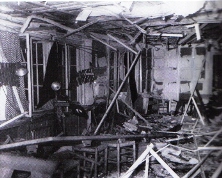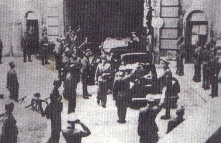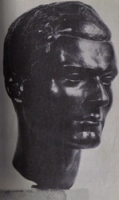![]()
Chapters
References
Introduction
 Wolfschanze conference room - July 20th, 1944
|
On July 20th, 1944 a powerful explosion ripped through Adolf Hitler’s Eastern Front Command Center code named Wolfschanze. A bomb placed inside a briefcase had gone off, destroying a conference room where Hitler, along with other members of the Wehrmacht and Nazi hierarchy were discussing the rapidly deteriorating situation along the Eastern Front. Just two years before, Hitler had become the de facto ruler of Europe after his lightning conquests of Poland, Denmark, Belgium, Holland and France. However, Germany’s stumbles in the years since 1942, most notably in North Africa and Russia, coupled with the recent invasions of Italy in 1943 and France in June 1944 by the Allied Expeditionary Force had begun to take its toll on an already overburdened military thrown haplessly into battle to fulfill the Fuhrer’s lust for empire. Due to these circumstances, a young German General Staff officer named Claus von Stauffenberg decided to act. As history shows us, Stauffenberg’s attempt failed. He met his end in the War Ministry Courtyard (Bendler Block) less than a day after the attempt. Many more would die from his actions in the ensuing months as the Nazis rounded up all of those even remotely associated with Stauffenberg’s plans, had them tried before a kangaroo court and hung from piano wire in Plotzensee Prison. Hitler survived the attack only to end his life eight months later as the Russian army closed in on his bunker in Berlin. The millions of dead from both sides speak to the tragic nature of the Nazi Regime and its tainted legacy that to this day still lingers. While it is
true that Claus von Stauffenberg did commit treason in the most
strict interpretation of the word by attempting to kill his
elected head of state, it is also reasonable to assume that he
acted as a German patriot who saw that Hitler was leading
Germany towards an abyss that no army or treaty would save them
from. Today, one can see that while Stauffenberg did try
to kill Hitler, he was only acting out of a sense of love for
his country, a country that Hitler was slowly destroying right
before his eyes. This web site will explore the reasons
behind Stauffenberg’s actions on July 20th, 1944 and
how the path of least resistance that many Germans took against
the Nazi Regime was really a path to nowhere.
Home
To Early Life and Influences
Site designed and maintained by Bill Jeffers
Public History at the University of North
Carolina at Charlotte
|


